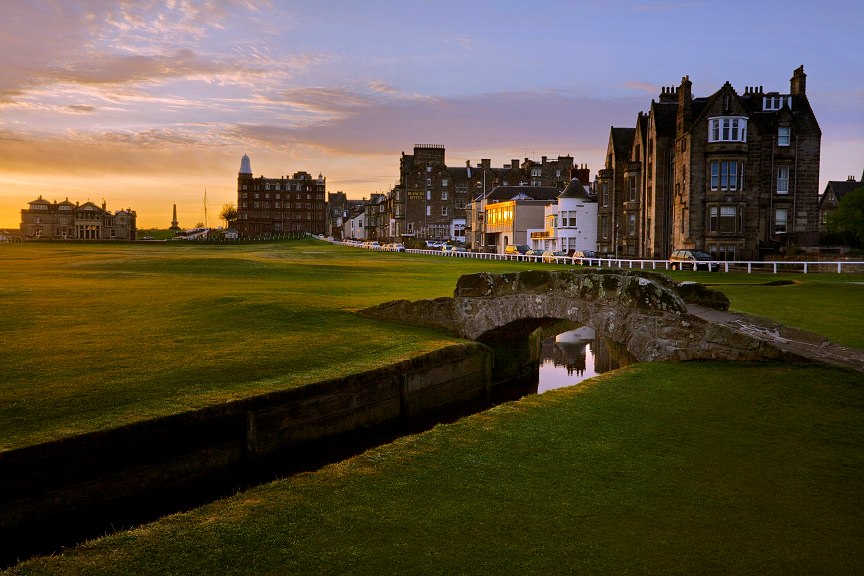As teaching professionals we are expected to understand all aspects of the golf swing.
Also for your student’s you should be ready to answer questions about the origin of the game.
The following is a recent article I wrote for Philadelphia Golfer Magazine.
For the past six centuries golf has been played on the Links at St. Andrews since around 1400 AD. The Old Course is renowned throughout the world of as the Home of Golf. However, it has not always been that way. Golf was becoming popular in the middle ages, and the game was banned in 1457 by King James II of Scotland who felt it was distracting young men from archery practice. And you thought you had problems convincing your wife that cutting the grass could wait another day. However, the ban was repeated by succeeding monarchs until James IV threw in the towel and in 1502 became a golfer himself.
The old course originally consisted of twenty-two holes, eleven out and eleven back. Upon completing a hole, the player used a handful of sand scooped out from the hole to form a tee and played the next hole. In 1764 the Society of St. Andrews Golfers, which later became the Royal and Ancient Golf Club reduced the course to eighteen holes and created what became the standard round of golf through the world.
Golf started to become even more popular at St. Andrews in the 19th century and the course became more crowded. The result was that golfers going out began to bump into other golfers playing the same holes. To solve the problem, the decision was made to cut two holes on each green having white flags for the outward holes and having red flags for the inward holes. This was the origin of the famous double greens, many of which could leave you with a 100 yard putt!
The Open Championship was first played on the Old Course at St. Andrews in 1873. With the 27th staging of the world’s premier golf event taking place again on the Old Course in 2005, St Andrew’s has held the event more often than anywhere else. In modern times, the Dunhill Cup and Dunhill Links Champions have been played at St. Andrews. The British Amateur Championship and competitions for men and women have been held over the fabled links at the Home of Golf.
The Old Course has evolved over time and was not designed by any one architect. The people who played a major role in shaping it are Daw Anderson (1850s), Old Tom Morris (1860s – 1900) and Dr. Alistair Mackenzie (1930s). The course is known for its particular physical features including 112 bunkers, some of which are especially famous e.g. “hell” on the long 14th, “Strath” on the short 11th and the Road Bunker at what is probable the most famous golf hole in the world, the 17th or Road Hole (so called because a road – which is in play – runs hard against the back edge of the green). I have had the opportunity to play from each of these bunkers (not by choice) over the years and I can assure you they are unlike any bunkers in the United States. Consequently, when you attend a National Golf School at St. Andrews you will have an extra short game session on how to play the bunkers of the Old Course.
I first played the Old Course in 1996 and immediately fell in love with it like so many other golfers. Jack Nicklaus said “I fell in love with it the first day I played it there’s just no other course that is even remotely close.” Tiger Woods said “Without a doubt I like it the best of all the Open venues. It’s my favorite course in the world.” The immortal Bobby Jones said “If I had but one course to play before I die it would be St. Andrews.” I decided that day I would try to bring this cherished course to as many American’s that I could by creating National Golf School’s first international golf school location at St. Andrews.
The Old Course has so many wonder full stories to tell. Over six centuries and 27 Open Championships the fortunes of the world’s greatest golfers played out on this wonderful golf course. The dapper Doug Sanders missed a 2 foot on the 18th of the 1970 Open and lost to Jack Nicklaus in an 18 playoff the next day. One Open in particular comes to mind when Tom Watson a five time winner of the Open was faced with a seemingly impossible shot on the Road Hole. Watson’s ball was a foot away from the wall with no back swing available. With the Championship in the balance, Watson faced the wall, hit his ball into the wall and it bounced off the wall across the road toward the green for a bogey. That shot was the turning point and it cost him the 1984 Open Championship. During a recent golf school at St. Andrews I tired to duplicate that shot. Well, the wall is uneven and as the ball ricocheted back toward the green it struck my ankle. As I limped up the fairway to the 18th green, with the Royal and Ancient Golf Club in the back ground I reminded my self to eliminate that shot from our short game session.
Over the years many golf school students have enjoyed the wonders of St. Andrews and the mystic of the Old Course along the way building their own special memories. What is truly remarkable about St. Andrews and the Old Course is that in today’s modern golfing world, the Old Course has evolved over six centuries, and remains a true test of championship golf. Join me at a National Golf School at St. Andrew’s and experience this special golf adventure. I agree hole heartedly with Bobby Jones if I had but one course to play before I die it would be The Old Course at St. Andrews.
Patrick J. Livingston, PGA
CEO, National Golf Schools
2003 & 2007 “PGA Florida Teacher of the Year”

